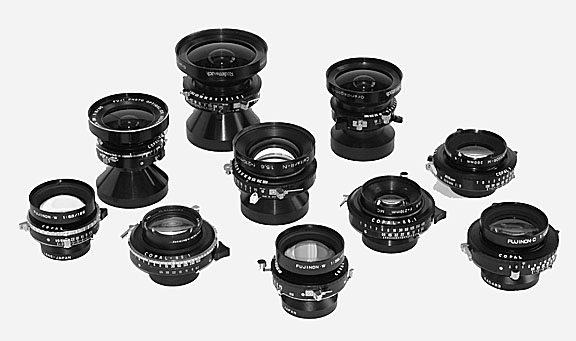
© 2002, 2007 by David C. Karp , for largeformatphotography.info

The subject of lenses and lens selection for large format cameras can be quite daunting for photographers new to the medium. Although large format lenses obviously serve the same purpose as lenses for 35mm, DSLR, and medium format cameras, they are clearly different in both appearance and operation.
This presented quite an obstacle when I began my foray into large format photography. I had no knowledge of the subject, and it seemed that no matter how hard I looked, the information I found was either too superficial, or assumed that the reader had a grasp of the basics. As a result, it was a long time before I felt even slightly comfortable with the subject.
This article is an attempt to distill what I have learned on the topic into a broad overview that assumes little or no knowledge on the reader's part. The intent is to help photographers new to large format make their way through the variety of view camera lenses and lens types, and make their early purchase decisions with a minimum of stress and confusion. Most of the discussion is about lenses for 4x5 cameras. This is because 4x5 is the most popular format, and since it is the format that I work in, it is the one I feel most competent to write about. Nevertheless, most of the concepts covered here are transferable to the other formats.
The discussion starts with an overview of a large format lens, and the basics of its operation. Next, the discussion turns to how to attach the lens to your view camera. This is followed by a brief discussion of lens types, a short review of the major lens manufacturers, and, finally, a discussion of how to select your first lens and assemble your lens toolkit.
A couple of caveats: First, some of the lenses mentioned below have been discontinued. They are still available used from a variety of sources. Second, I am not a lens "expert," and especially not a "lens design expert." Good sources for basic information on lens design are the Large Format Photography Forum, and Jim Stone's A User's Guide to the View Camera, in its third edition, published by Prentice-Hall. There are also other more technical books on the subject. One source to investigate is Rudolf Kingslake's A History of the Photographic Lens.
The instant you see a large format lens you know it differs from your 35mm, DSLR, or medium format lenses. For one thing, unlike those smaller formats' sleek lenses with nearly silent autofocus or wonderfully tactile knurled focusing rings, the large format lens has no focusing apparatus at all. Instead, view camera lenses bristle with levers, dials, knobs, and connections that protrude every which way. Their unique appearance can be quite unsettling, even for the most experienced small or medium format photographer, because the purpose of all these controls is not always clear.
A typical large format lens is shown below, a Nikkor M 300mm f/9.0. On close inspection, it turns out that a large format lens is actually quite simple. It is divided into two sets of lens elements. One set is screwed into the front of a leaf type shutter, while the other set is screwed into the back of the shutter. The levers and other controls are part of the shutter.
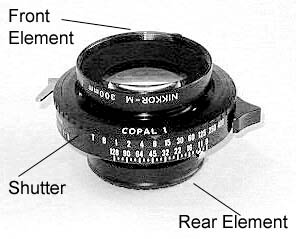
Nikkor M 300mm f/9.0 on a Copal No. 1 Shutter
The most important controls are the lever to adjust the aperture blades, the ring to set the shutter speed, the lever to release the shutter, and the preview lever that opens the shutter blades so you can preview and focus the image. (Note that Fujinon large format lenses are mounted on a slightly different version of the Copal shutter shown below. Fujinon Copal shutters do not have the aperture adjustment lever on the top of the lens. Instead the lever is on the bottom, and looks like a smaller version of the round shutter cocking lever.) Another control provides a PC contact that enables you to trigger a flash. These controls are all shown in another view of the same lens:
Shutters come in different types and sizes. Today, the most common type is the Copal shutter, which is a leaf type shutter available in three sizes. The Copal No. 0 shutter is the smallest and lightest at four ounces. The Copal No. 3 shutter, at twelve ounces, is the largest and heaviest. The Copal No. 1 shutter falls in between (but, at 5.6 ounces, is closer in size and weight to the No. 0).
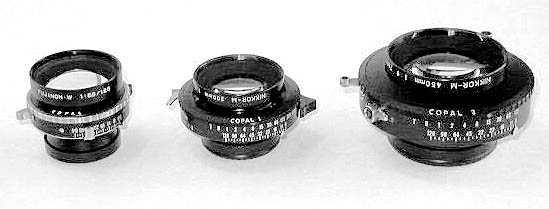
Copal Shutters - from left to right - Fujinon W 125mm f/5.6 on Copal No. 0, Nikkor M 300mm f/9.0 on Copal No. 1, and Nikkor M 450mm f/9.0 on Copal No. 3
Another important difference between the three Copal shutters is their maximum shutter speed. The Copal No. 0 has a maximum speed of 1/500 second. The Copal No. 1 shutter tops out at 1/400 second. The Copal No. 3 has a maximum shutter speed of 1/125 second. All three sizes include speeds in standard intervals to one second, along with Bulb and Time.
There are several other shutter types, current and historical, for large format lenses, including Compur, Ilex, Graphex, Seiko, Supermatic, Packard, Prontor, and Sinar's proprietary DB shutter system. For more detailed information on shutters for large format lenses, see the article "Shutters" under the Accessories section of largeformatphotography.info,, and this site.
Now that you know what all those controls are, here is what you do with them. First, move the preview lever upward to open the shutter blades. (I was taught not to open the shutter if it was cocked because this would harm the shutter. I have since learned that this is probably not true. Nevertheless, since it never feels "right" to me when I open a cocked shutter, I still try to trip it before moving the preview lever to the open position.) Next, frame and focus the image. Once you are done, move the preview lever downward to close the shutter. Next, set the shutter speed by rotating the shutter speed adjustment ring.
Many photographers think that it is a good idea to "exercise" the shutter by firing it a few times prior to making the exposure. This is supposed to insure that the shutter opens and closes at the proper speed. Others disagree completely, claiming that exercising the shutter does not guarantee it will fire at the proper speed. There is, however, a good reason to exercise the shutter at least once as part of your regular routine. By trying to fire the shutter before pulling the darkslide from the film holder, you will always make sure that you close the preview lever. This is because the shutter will not fire if the lens is in preview mode. It will fire if the preview lever is in the closed position. If the lens is open, the disturbing noise you hear when you try to trip the shutter serves as a reminder to close it. This helps avoid accidental exposures and unnecessary waste of film.
To exercise a shutter, or to make the exposure, you must first cock the shutter. Just move the cocking lever until it cannot move any further. You will feel a click when the shutter is cocked. Let go of the lever, and it will flip back to its original position. The shutter is now ready to fire. Trip the shutter release lever by depressing the plunger on your cable release. (Do not trip the lever with your finger when making a photograph. It is next to impossible to do this without shaking the camera.) That's all there is to it - Not nearly as complicated as it appeared at first glance!
Large format photographers will often see advertisements for used lenses with the notation "in a barrel," or "barrel lens." These lenses do not have a shutter. Barrel lenses were used on reproduction cameras that were once very common in the graphic arts industry, or for those few large format cameras that featured their own shutter. Barrel lenses were manufactured by all of the well-known lens manufacturers. Examples of familiar lenses available in a barrel include Goerz Artars and Dagors, Nikon APO-Nikkors, Kowas, Computars, Rodenstock APO-Ronars, and Schneider Repro-, G- or APO-Clarons.
In some cases, these lenses will fit directly into a shutter (even so, remember the shutter will still need the appropriate aperture scale). In other cases, a very handy photographer or a photographic machinist like S.K. Grimes can adapt the barrel lens to fit into a shutter. S.K. Grimes' website has an excellent discussion of this process, and a list of lenses successfully mounted to a shutter. A Packard shutter is also a possibility when using barrel lenses. (See here as well.) Another option is to use a barrel lens in conjunction with a watch and black card (or hat) to cover the lens before and after the exposure. Many of the lenses used in the graphic arts industry had quite long focal lengths and good coverage (see the section entitled Image Circle, below), making them particularly attractive for use with the larger formats, 8x10 and up. Lenses in a barrel can be an excellent value, especially if the price is low enough to support the cost of a shutter and the associated machining work, or if the photographer wants to use it with a Packard Shutter.
Most smaller format cameras do not offer movements (i.e., rise, fall, shift, swing, or tilt). As a result, their lenses need only to project an image that covers the size of the film format. In contrast, most view cameras offer a variety of movements, some of them very extensive. This means that the lens must project an image large enough that the lens can "move around" within the image as the photographer applies the camera movements. So, the larger the lens's image circle, the more extreme the movements available to the photographer (within the limits of the camera's design).
The image circle is an important factor to consider whenever buying a view camera lens. Always be sure that the lens you are buying has, at minimum, an image circle that will cover your film size. A lens for a 4x5 camera must have an image circle of 6½ inches, or approximately 165mm, to just barely cover a sheet of 4x5 film. An 8x10 camera needs a lens with an image circle of 13 inches, or approximately 330mm to cover its film (without any movements). To calculate the minimum image circle required for your film format, take the diagonal measurement of a sheet of that film. This will give you the minimum image circle for all lenses to be used with that format.
Fortunately, lens manufacturers make it easy to determine whether a lens will, at minimum, cover your film format. They provide specifications showing the size of a lens's image circle at f/22 (or sometimes f/16). The image circle is often referred to as lens "coverage." This information is invaluable because once you know (1) your minimum required image circle and (2) the amount of movement provided by a lens, you can compute the amount of excess lens coverage. This gives you the extent of the movements supported by that lens. Another valuable resource for information about lens coverage (and many other bits of information about large format lenses) are the pages on Specs for New Large Format Lenses, and a similar compilation regarding older lenses, which are part of this website.
Once you know the excess coverage provided by a lens, you can compare it to your needs. Consider how much movement you need (or your camera will allow), and compare it to a lens's excess coverage. Certain applications, photographing architecture for example, require generous image circles. Other uses, such as hand held press camera work, call for lenses with smaller image circles. Lenses with extra large image circles and large maximum f/stops may be larger, heavier, and/or more expensive than you need. Generally, lenses with lesser image circles will be lighter and smaller than lenses capable of extreme movements. There is no one right selection for everyone. It all depends on the photographer's interests and budget. (See the discussion on building a lens kit, below.)
Unlike lenses for smaller format cameras, a large format lens does not have an integral mount to attach it to the camera. Instead, most large format lenses and cameras use a much different (and more "low tech") mounting system. The lens is affixed to a lensboard, which, in turn, is attached to the camera. Each lens should have its own lensboard. This is because, as we shall see, attaching a lens to a lensboard is a procedure that is not practical to repeat over and over again. This is especially true when working outdoors.
Lensboards for most cameras are usually available in two varieties: Flat and recessed. The flat lensboards are used with lenses in the normal and long focal length ranges. Recessed boards are designed for use with wide angle lenses when a camera's front and rear standards cannot be moved close enough to focus the wide angle lens when using a flat lensboard. They help bring the rear element of the lens closer to the film plane, and, combined with a very flexible bag bellows, make it possible for the photographer to take advantage of the lens's full range of movements. Recessed boards are usually more expensive than flat lensboards.
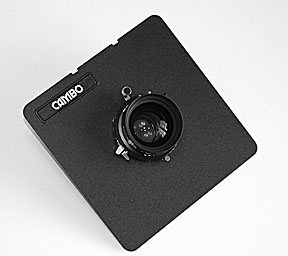
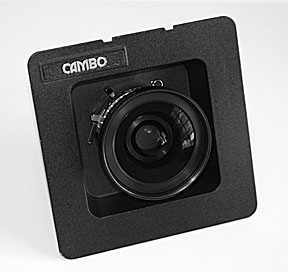
Cambo flat (L) and recssed lensboards (R). The lens on the left is a Fujinon NW 150mm f/5.6. The lens on the right is a Rodenstock Grandagon-N 90mm f/4.5
Lensboards are usually made of metal or wood, and require a hole large enough to accommodate the shutter and rear lens element. In this sense, lensboard designs are universal. The hole for mounting the lens is sized based on the size of the shutter affixed to the board. Lensboards are usually available either pre-drilled in sizes for Copal No. 0, No. 1, or No. 3 shutters, or undrilled.
To attach a lens to a lensboard, carefully unscrew the rear lens assembly from the shutter by turning it counterclockwise. Then similarly unscrew the mounting flange from the back of the shutter. Place the shutter over the hole in the lensboard, and hold it in place by screwing the flange back onto the shutter. (You may find that your lens has a small screw on its backside. This screw is designed to fit into a notch on the lensboard so the lens does not rotate on the board. Most photographers discard the screw, as many boards don't have the notch, or because they want the flexibility to mount the lens in whatever orientation they desire.) Tighten the flange with an adjustable spanner wrench, or with a dedicated mounting wrench that mates with the notches on the mounting flange. These dedicated wrenches have separate fittings for different shutter sizes (my Rodenstock wrench has fixed notches for use with No.0, No. 1, Copal/Compur No. 3, and Prontor Professional No.3 size shutters). They are small, lightweight, and fit easily into your camera case or backpack. (Wrenches of this type are available from Rodenstock, Toyo, and Midwest Photo Exchange).
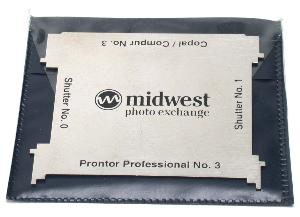

Lens Mounting Tools - from left to right - Dedicated Lens Mounting Wrench and Adjustable Spanner Wrench (Photos courtesy of Midwest Photo Exchange)
Do not over tighten the flange. Once the flange is secure, make sure that there is no dust in the shutter or the rear lens assembly, and carefully screw the rear portion of the lens back into place. This operation is simple, but delicate. Take care not to damage the shutter blades or scratch the lens element. It is best to do this work with a minimum of distractions.
Typically, lensboards are attached to the camera by sliding the bottom of the board under some retaining tabs or a lip on the front of the camera, pressing the board flush against the camera front, and sliding a retaining bar or similar device over the top of the board. Some cameras feature an automatic locking mechanism to hold the board in place. Below are just a few examples of lensboard attachment devices:
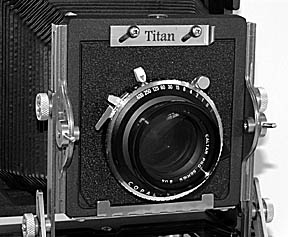
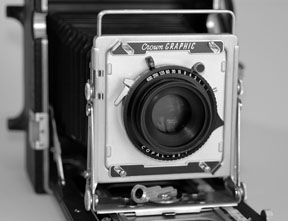
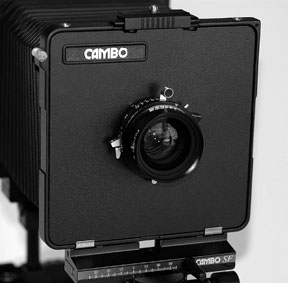
Lensboard Attachment Devices: Walker Titan SF, Pacemaker Crown Graphic, and Cambo 45SF
There is very little standardization in lensboard size or shape. Camera manufacturers produce lensboards to match the specific needs of their camera designs, without apparent regard for the boards used on other cameras. There is, however, some small amount of standardization (or more appropriately, commonality) in view camera lensboards. For example, many 4x5 field cameras use the Linhof Technika type lensboard, including the Linhof Technika and Technikardan, Ebony, Wista, Horseman, Tachiahara, Gandolfi, Lotus, and Shen Hao. Other cameras can be special ordered to accept Technika type boards, such as the Canham wooden cameras, or Gowland lightweight monorail cameras.
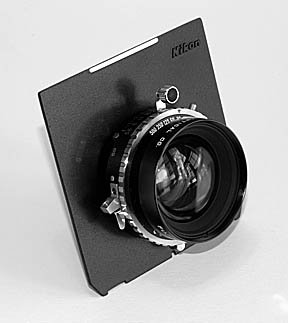
Fujinon NW 125mm f/5.6 lens mounted on a Technika-Type Lensboard (Nikon brand)
Similarly, Toyo and Canham 4x5 field cameras share a similarly sized lensboard and can, to a certain extent, exchange boards. (See the reviews and comments for Canham cameras in the "Camera Reviews" section of largeformatphotography.info.) Some wooden 4x5 field cameras and older Calumet monorails use a 4"x4" lensboard. Finally, Sinar, and Horseman 4x5 cameras, and Tachihara (and other) 8x10 cameras share similar lensboards, which can be interchanged.
The wide variety of lensboard sizes and shapes can be overcome to a certain extent. Several manufacturers provide lensboard adapters that allow smaller lensboards, like the Technika, Graphic, or Toyo Field type boards, to work with their cameras. Similar adapter boards are available from various camera manufacturers. Additionally, experienced photographic machinists and repair persons, such as Richard Ritter or S.K. Grimes, can custom fabricate lensboard adapters for use with many camera types.
This type of adapter can be convenient for a number of reasons. The first is to benefit the photographer who owns multiple camera types or brands. When a photographer has both a monorail and field camera, an adapter board for the larger monorail camera enables standardization on a single lensboard type. The second reason is to reduce the storage area required by lensboards. Some cameras feature quite large lensboards, which are heavier and take up a lot of room in a camera case or backpack. An adapter board makes it possible to use smaller boards, saving both space and weight.
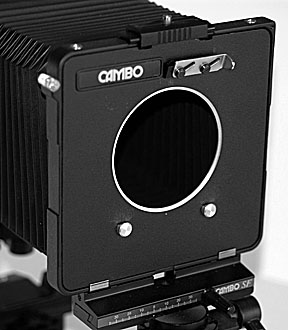
|
|
Photographers should, however, be aware of a disadvantage inherent in small recessed lensboards. These can be quite cramped, with very little room available to operate the aperture or shutter speed controls. Some are so small that they cannot accommodate the larger shutter sizes, thereby limiting the universe of usable lenses. Even with larger recessed boards, the space available to operate the shutter controls is almost always cramped. The smaller the board, the less room for important things, like your fingers.
Finally, some manufacturers, such as Wista, provide lensboard extensions that enable macro photography, or the use of longer lenses with less bellows extension. (A photographic machinist is another potential source for a lensboard extension if none is available for your camera.) Essentially, these boards supplement the camera's maximum bellows extension, allowing either closer focus, or the use of a longer lens than would otherwise be possible with a given camera.
Used lensboards are often available, and buying a used board can result in significant savings. Some photographers fashion their own lensboards from aluminum, wood, plastic and other materials.
Normal Lenses
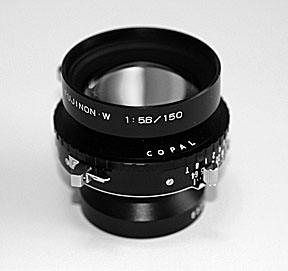
Many photographers start their large format lens kit with a "normal"
lens. Technically, most photographers consider the 150mm lens
the normal lens for a 4x5 camera. In practice, lenses from 135mm
to 180mm (and for some photographers, even 210mm) are considered
"normal" for a 4x5 camera. (Double these focal lengths
to determine the range of a normal lens for the 8x10 camera.)
The choice of normal lens focal length is based on a variety of
issues, the most important factor being the photographer's interests
and choice of subject matter. Other issues include the range of
lenses a photographer intends to use with the camera, and the
size of the lens (some photographers want to be sure the lens
can be folded into a field camera). Some photographers select
a normal lens, and never buy another lens for their camera. Others
skip the "normal" focal length range entirely.
Long Lenses
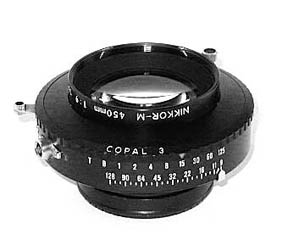
Nikkor M 450mm f/9.0
Although some photographers consider the 210mm lens "normal,"
it really is at the short end of the "long" focal length
range for the 4x5 camera. The 210mm is perhaps the most common
4x5 long lens, but many photographers regularly use 240mm, 300mm,
450mm, or longer lenses. Of course, the larger formats can use
even longer lenses. The only real limiting factors in the use
of long lenses are size, weight, coverage, and bellows extension.
In general, the longer the focal length, the bigger and heavier the lens. Long lenses above 210mm with wide maximum apertures of f/5.6 are mounted in Copal No. 3 shutters (like the one shown above on the relatively compact Nikkor M 450mm lens). A Copal No. 3 is more than twice as heavy as the next largest size, the Copal No. 1. Many "long" long lenses are very heavy, and require a camera and tripod rigid and stable enough to handle the weight.
Not all long lenses are huge. Smaller lenses are available to photogrpahers who are willing to accept a smaller image circle and a smaller maximum aperture. These lenses are often simpler designs, using fewer lens elements. For example, a Rodenstock APO-Ronar 300mm f/9.0 is in a Copal No. 1 shutter and uses 49mm filters. It is far smaller than another Rodenstock, the 300mm f/5.6 APO-Sironar-N, which is in a Copal No. 3 shutter and uses 86mm filters, or a Rodenstock APO-Sironar-S 300mm f/5.6 in a Copal No. 3, and its 100mm filters! Lens choices from other manufacturers in this focal length offer similar differences. In general, the biggest price you pay for the smaller size is a somewhat dimmer image on the ground glass, and a smaller image circle.
The last issue, bellows extension, is camera specific. If your camera does not have enough extension capability to handle a long lens of a given focal length, you are limited to a telephoto design at that focal length (see discussion below). For example, many of the more compact field cameras have a maximum bellows extension of 12 inches (approximately 300mm). At full extension, one of these cameras would barely be able to focus a 300mm long lens at infinity. Since you would not be able to focus closer than infinity, this renders the 300mm relatively unusable with such a camera. Standard design lenses of 240mm or 270mm are better candidates for use with cameras in this category.
Telephoto Lenses

Nikkor T 720mm f/16.0 Telephoto Lens Note the 360mm front element and 720mm rear element. See the discussion of Nikon lenses, below (Photo courtesy of Q.-Tuan Luong)
It is important to distinguish between "long" and "telephoto"
lenses. Smaller format photographers are accustomed to referring
to long focal length lenses as telephoto lenses. In fact, telephoto
lenses for large format cameras are very different in design and
operation from standard design long focal length lenses. This
was a very confusing issue for me, and it took quite a bit of
research before I felt comfortable enough to make an intelligent
decision on whether or not to purchase a telephoto lens. Here
is a summary of what I learned:
Long lenses for large format cameras are not necessarily telephoto designs. A standard long lens will often have the same design as the "normal" lens for that camera. For example, a Schneider 150mm f/5.6 APO-Symmar L lens has the same basic design as a Schneider 210mm APO-Symmar L f/5.6 lens. The longer focal length lens is simply larger, and comes in a larger shutter. In contrast, the Schneider APO-Tele-Xenar, 250mm f/5.6 telephoto lens is very different in appearance and design compared to the 210mm APO-Symmar L with a roughly similar focal length and maximum aperture. The story is similar when Nikon's "W" series lenses or Fuji's "CMW" series lenses are compared to their respective "T" series telephoto lenses. (Rodenstock does not offer telephoto design lenses.) The design differences between telephoto and non-telephoto lenses have significant consequences for large format photographers, as we shall discuss below:
There are three key differences between long and telephoto lenses. The most significant practical difference is the telephoto's lesser bellows draw requirements. To focus at infinity, a standard lens requires a bellows extension roughly equal to the lens' focal length. So, a 300mm standard design lens requires approximately 300mm of bellows extension to focus at infinity. It needs even more extension to focus closer. In contrast, a telephoto lens requires much less bellows to focus at infinity: In most cases, roughly two thirds of its focal length. A 300mm telephoto, therefore, needs only 270mm of bellows.
The second key difference is the location of the lens's optical center, also called its nodal point. Most normal lenses have nodal points located roughly in the center of the lens, near the shutter. In contrast, the optical center of a telephoto is located in front of the lens. Practically, this means that applying axis tilts on a non-telephoto lens causes the lens to tilt at or near its optical center. As a result, the image moves very little on the groundglass. In contrast, the location of a telephoto lens's optical center causes the image on the ground glass to move as the lens tilts. This requires repositioning the groundglass or the lens (via camera movements) to reframe the photograph. This may make it is more difficult to use front tilts and swings with a telephoto than with a standard lens.
A third important difference is that telephoto lenses have a smaller image circle than the standard long lens with an equivalent focal length. This limits the range of available camera movements.
The chief advantage of a telephoto lens is when a camera has a restrictive maximum bellows extension (as is very common with small, lightweight field cameras). Telephoto designs enable use of a longer focal length than would otherwise be possible with such a camera. In other situations, most photographers recommend working with long focal length standard design lenses.
There are other differences. For a full discussion of telephoto lenses and their use, see the article The Telephoto Lens in the March/April 1991 issue of View Camera Magazine.
Wide Angle Lenses
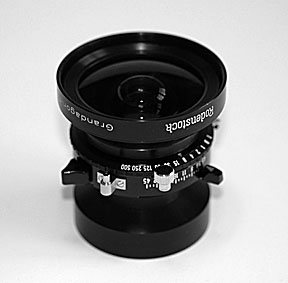
Rodenstock Grandagon-N 75mm f/4.5
Wide angle lenses for 4x5 cameras start in the 125mm range, and
move down from there. Wide angle lenses fall into several groups.
I call them gentle wide (125mm to 110mm), wide (90mm to 80mm),
very wide (75mm to 72mm), super wide (65mm), and unbelievably
extremely wide (58mm to 47mm). Wider focal lengths, like the 35mm
and 45mm Rodenstock APO-Grandagons or the 38mm Schneider Super
Angulon XL do not cover 4x5, but will cover the 6x12 (Rodenstocks)
or 6x9 (Schneider) formats.
Perhaps the most popular wide focal lengths for the 4x5 are the 90mm and 75mm lenses. Manufacturers usually offer two versions of the 90mm, and in the past, sometimes two versions of their 75mm as well. One version has a large maximum lens opening (with a much bigger front element requiring a bigger filter), while the other has a smaller max lens opening (and is less expensive, smaller and lighter than the big version). The large lens openings are generally f/4.5 (Rodenstock, Caltar, Nikon) or f/5.6 (Schneider, Fujinon), and the smaller openings are either f/6.8 (Rodenstock, Caltar, and the current Schneider Super-Angulon) or f/8.0 (Nikon, Fujinon, and the older Schneider Super-Angulon). The f/4.5-f/5.6 versions are significantly larger and heavier than the f/6.8-f/8.0 versions.

Photo of two 90mm lenses shown side-by-side for size comparison: Rodenstock Grandagon-N 90mm f/4.5 (L) uses 82mm filters. Fujinon SW 90mm f/8.0 (R) uses 67mm filters.
Typically, the more expensive larger wide angle lenses offer a bigger image circle. (The Nikkor SW 90mm f/8.0 is the exception. Its image circle equals that of most of the larger and more expensive 90mm lenses.) Lenses in the Schneider Super-Angulon XL series offer the largest image circles. Rodenstock (and Caltar) currently offer the largest maximum apertures at f/4.5. (Nikon has discontinued its Nikkor SW 65mm f/4.0.)
The lenses with larger maximum apertures are often considered critical for architectural work, because (1) their larger image circles are required for perspective correction, and (2) their larger maximum aperture makes it easier to focus the camera in the dim light typically encountered in architectural interiors. In contrast, the smaller, lighter lenses (with the smaller maximum apertures) are usually preferred by landscape photographers because (1) they carry their equipment long distances on their backs, (2) larger image circles are not usually required to photograph the landscape, and (3) photographing outside in bright daylight helps overcome the smaller maximum aperture.
Wide angles have their own unique characteristics. The image they project on the ground glass is dimmer than that from normal or long lenses. The brightness falls off sharply toward the corners. Beware, the wider the lens, the more extreme these effects. These factors can make it hard to focus a wide angle lens, especially dim light. Also, wide angle lenses can distort an image, especially at the edges. Wide angles may require additional accessories for your camera, most likely recessed lensboards, a fresnel lens, and a flexible bag bellows.
Convertible Lenses
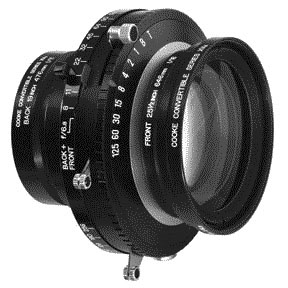
Cooke Series XVa Triple Convertible Lens (Photo courtesy of Cooke Optics Ltd.)
Historically: At one time, many large format lenses were convertibles. These lenses were attractive because they gave the photographer two or more lenses in one. Removing the front element of a convertible lens increases the focal length. With a triple convertible, using either the front alone, rear alone, or both elements together gives the photographer three different focal lengths in one lens.
Without going into great detail regarding these historically interesting lenses, it is safe to say that, traditionally, there were compromises with these designs. While the shorter, "unconverted," focal length is usually a good or even excellent lens, "converting" it by removing an element generally resulted in reduced image quality. One way to improve image quality when using black and white film with a "converted" lens is to place a yellow filter in front of it.
Many photographers feel that these older convertible lenses are greatly inferior to today's excellent range of single focal length view camera lenses. On the other hand, it is undeniable that many outstanding photographs were made with convertibles. Some of Ansel Adams' classic photographs, including "Moonrise," Hernandez New Mexico, "Clearing Winter Storm," Yosemite National Park, "Aspens," Northern New Mexico, and "Mount Williamson" from Manzanar, California were all taken with a Cooke Series XV triple convertible lens. (We should all be similarly hampered by such inadequate equipment!) Many photographers feel that older convertibles are especially appropriate when making negatives for contact printing.
Users can often find excellent values in used convertible lenses, which will give them a fine prime focal length, and, at the very least, a serviceable longer focal length when converted. If you are interested in a used convertible, older Schneider Symmar lenses (not the APO-Symmar-L, APO-Symmar, or the Symmar-S models) are good choices. Other classic convertible lenses include the Bausch and Lomb Protar, the Wollensak triple convertible Velostigmat 1a or Raptar 1a, the Turner Reich triple convertible, and the aforementioned Cooke Series XV.
Convertible Lenses Today: Cooke Optics, of the UK, created quite a stir in the large format world recently by introducing their brand new Series XVa Triple Convertible lens. This single lens can provide three focal lengths: 645mm (front cell only), 476mm (back cell only), and 311mm (front and back cells). If you purchase a second set of lens elements, five focal lengths are possible, from 273mm to 476mm! The Series XVa is a modern redesign of Cooke's classic Series XV triple convertible, mentioned above.
I have seen comments from several users who have raved about the lens. Unlike the traditional convertibles, the Series XVa is multicoated, and available on a modern Copal No. 3 shutter. Depending on the photographer's needs, this one lens might be the ideal alternative for use with an 8x10 field camera. For more information, see Badger Graphic's description and specification pages for this lens, and a discussion of the lens by photographer Clive Russ.
Wisner Classic Manufacturing also shows a convertible lens in its catalog, the Wisner Convertible Plasmat. The set is a replica of the Protar, and is made up of several single lens cells that can be combined to create a variety of focal lengths. The 4x5 and 5x7 sets are mounted on a Copal No. 1 shutter. The 8x10 set is mounted on a Copal No. 3 shutter. A yellow filter is required with black and white film. An item called a "zero power corrector" is required to correct color fringing and other issues when using color film. According to Wisner, Schneider manufactures the optics to Wisner's specifications. The lenses are assembled and tested by Wisner. For more information, see the article by Jean-David Beymer for this site.
Today, most large format lenses are manufactured by the companies
known to many as the "Big Three." They are (in alphabetical
order) Fuji, Rodenstock, and Schneider. Not too long ago, these
companies were three of the "Big Four." What happened?
Alas, in 2006, Nikon ceased production of its large format lenses.
Nevertheless, Nikon lenses are discussed below because (1) Nikon
lenses will be available new for as long as stock holds out, and
(2) there are many used Nikon large format lenses available.
You will find that each manufacturer has a group of strong adherents. When these photographers gather to discuss the relative merits of their favorite manufacturer's lenses, the "discussions" can verge on fanaticism. The fact is that all four manufacturers make (or made) excellent lenses. Without looking very hard, you can find many outstanding photographers who standardize on lenses from each of these manufacturers. You will also find many outstanding photographers who have lenses selected from two or more of these manufacturers. Don't be swayed by other photographers' preferences. Make your own evaluation.
The following discussion is based on my personal experience, discussions with other photographers, and written reviews from a variety of sources. Any omissions or mistakes are inadvertent.
Fujinon
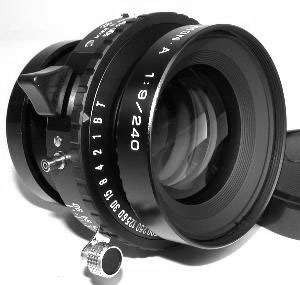
240mm f/9.0 Fujinon A (Photo courtesy of Midwest Photo Exchange)
Fuji, of Japan, manufactures a full line of Fujinon large format lenses. These lenses are not widely distributed in the United States because there is no longer an official importer. Nevertheless, and luckily for large format photographers in the U.S.A., several retailers directly import Fujinon lenses, including Badger Graphics, Charles P. Farmer Photography, and Midwest Photo Exchange. Another source is Robert White (in the UK). In addition, used Fujinon lenses are available, often at very reasonable prices.
Fujinon lenses are currently manufactured in the following series: "CMW" (standard general purpose), "C" (compact, lightweight lenses), "SW" and "SWD" (wide angle), "T" (telephoto), and "SF" (soft focus lenses used in portraiture). In addition, new lenses in the "A" series (apochromatic lenses for close up photography - suitable for general photography as well) are still available, despite reports that they have been discontinued.
The Fujinon line is particularly strong in the compact, lightweight lenses favored by landscape photographers. Noteworthy lightweight Fujinon lenses include the Fujinon "C" 300mm f/8.5 and "C" 450mm f/12.5 (a very long focal length mounted in a small Copal No. 1 shutter). Other highly regarded lightweight Fujinons, the "A" series, are now discontinued, but might be available out of remaining retail stock or from used lens dealers. The "A" 240mm f/9.0 and 300mm f/9.0 are light, small, and much sought after lenses that cover 8x10. The "CMW" lineup offers several excellent choices, all with generous movements for lenses in this classification. Fujinon telephoto lenses are also highly regarded, and are excellent choices for photographers who have cameras with limited bellows draw. For used lenses, I find the Fujinon "NW" series (the predecessor to the CM-W series) with EBC multicoating an outstanding value.
It is sometimes difficult to be sure which Fujinon lens is which by looking at the information on the lens itself. This is because Fuji did not always include the full name of a new series on the lens barrel, even though the full name was shown in the literature and on the packaging! For example, even though the "NW" series was an upgrade from the Fujinon "W" series, with new designs and multicoating, the lenses themselves are labeled "Fujinon W." For detailed information on Fujinon large format lenses, the authoritative resources are the retailers mentioned above, photographer Kerry Thalmann's excellent article Fujinon Lenses: Past and Present, in the November/December 2001 issue of View Camera Magazine, and his Fujinon Lens website. Another very good source that will help sort out one version of a Fujinon lens from another is The Web's Most Complete Fujinon Large Format Lens List.
Nikon

135mm f/5.6 Nikkor W (Photograph Courtesy of Midwest Photo Exchange)
The last lineup of Nikon large format lenses was produced in the following series: "W" (standard general purpose), "SW" (wide angle), "M" (compact long lenses), "AM" (macro), and "T" (telephoto).
One of Nikon's notable offerings was a series of modular telephoto lenses. These lenses allow the photographer to change focal lengths by removing the rear lens element and replacing it with another element. The "T" 360mm f/8 lens can accept two different rear elements to become a 500mm f/11 or a 720mm f/16. Similarly, the "T" 600mm f/9.0 can be converted to an 800mm f/12.0 or 1200mm f/18.0 simply by swapping rear lens elements.
In wide angles, unlike any of the other "compact" 90mm lenses, the Nikkor SW 90mm f/8.0 has an image circle directly comparable to the larger Nikkor SW 90mm f/4.5 (as well as the Rodenstock 90mm f/4.5 Grandagon-N, the Fujinon SWD 90mm f/5.6, and the older Schneider 90mm f/5.6 Super Angulon). Other notable member of the Nikkor "SW" wide angle series are the Nikkor SW 120mm f/8.0, which covers 8x10, and the SW 65mm f/4.0, which has the widest maximum aperture of any of the modern 65mm lenses offered by the former Big Four. The Nikkor "M" series compact long lenses are also much adored by landscape photographers, particularly the 200mm f/8.0 and 300mm f/9.0, which are quite small and lightweight. The Nikkor "W" series standard lenses are workhorses used by photographers around the world.
Rodenstock
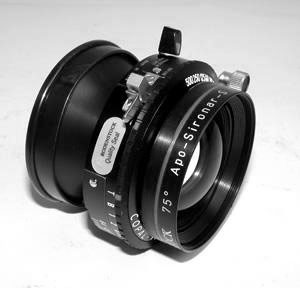
150mm f/5.6 Rodenstock APO-Sironar-S (Photo courtesy of Midwest Photo Exchange)
Rodenstock lenses are manufactured in Germany. Rodenstock lenses in popular focal lengths are (or were) available in multiple performance levels (all reputedly excellent), at different price points.
Rodenstock lenses are currently available in the following series: APO-SIronar-N (standard general purpose lenses, now available in only 150mm and 210mm focal lengths), APO-Sironar-S (enhanced performance general purpose lenses with larger image circles than the N series), APO-Macro-Sironar (macro), APO-Grandagon (extreme wide angle), Grandagon-N (wide angle), and the APO-Sironar-Digital (high performance lenses with smaller image circles for use with digital or roll film backs). Discontinued Rodenstock lines include the Geronar series (lower-priced, multicoated, and light weight three element designs), and the APO-Ronar series (designed for use at 1:1 reproduction ratios).
Among the celebrated Rodenstock lenses is the APO-Sironar-S series, which is said to be extremely sharp and excellent. The 150mm f/5.6 APO-Sironar-S is many a photographer's favorite lens. This series features ED (extra low dispersion) glass, and larger image circles than other lenses in the same category. The APO-Grandagon (35mm [6x12 format], 45mm [6x12 format], and 55mm f/4.5) and Grandagon-N (65mm through 90mm) series are highly regarded wide angle lenses. The 90mm and 75mm f/4.5 Grandagon-N lenses offer maximum apertures greater than or equal to the largest lens opening of any comparable lenses. The discontinued APO-Ronar series, while designed for close up work, is also sought after by photographers who like small, lightweight, and extremely sharp long lenses.
For more information on Rodenstock lenses,
consult the article Rodenstock Lenses: Past to Present
by Kerry Thalmann in the September/October 2002 issue of View
Camera Magazine. You can also obtain information on Rodenstock
lenses by visiting Rodenstock's
website, or photographer
Paul Butzi's unofficial site with information on Rodenstock
lenses.
Schneider
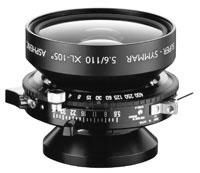
110mm f/5.6 Schneider Super-Symmar XL (Photo courtesy of Schneider Optics)
The German-manufactured Schneider lenses have long been popular with large format photographers the world over. Some of the most popular focal lengths (150mm and 210mm) are available in multiple performance levels. Schneider lenses are retailed throughout the United States.
Schneider currently offers lenses in the following series: APO-Symmar-L (general purpose lenses - recently introduced), Super-Angulon XL (wide angle lenses with large image circles for a given focal length), Super Angulon (a 90mm f/6.8 wide angle), Super-Symmar XL (80mm to 210mm wide angles with an aspheric lens surface), Makro-Symmar HM (macro), APO-Tele-Xenar, Fine Art XXL (limited production lenses for 8x10 through 20x24 cameras), and Digitar (high performance lenses with smaller image circles for use with digital or roll film backs). Discontinued lines of interest include the G-Claron (optimized for 1:1 reproduction, single-coated), and Xenar (lower priced, single coated, small, and lightweight 150mm and 210mm lenses - not to be confused with older Xenars from an earlier era).
Schneider lenses of particular note include the Super-Symmar XL series with their aspherical lens elements. The 110mm f/5.6 Super-Symmar XL lens is extremely popular, and often listed as a "favorite" lens in many a photographer's arsenal. The Super-Angulon XL series offers unmatched image circle sizes for those (like architectural photographers) whose work requires extreme camera movements. The 47mm Super-Angulon XL will cover 4x5, and is the widest lens available for that format. The new APO-Symmar-L series are said to be excellent, and quite sharp. Schneider discontinued its single coated G-Claron series, but unsold lenses may still be available from some retailers. These lenses are popular for general photography when stopped down to f/22 or more due to their small size, light weight and excellent performance.
More information on Schneider lenses is available in Kerry Thalmann's articles Schneider Lenses: Current to Past, Part I, in the November/December 2002 issue of View Camera Magazine, and Schneider Lenses: Current to Past, Part 2, in the January - February 2003 issue of the same magazine. Schneider's website offers a wealth of information about its lenses (current and historic).
Private Brands
An interesting aspect of large format lens choice is the availability
of high quality private label lenses. Unlike some of the private
label or "off brand" lens choices available to 35mm
photographers, most large format private label lenses are fine
lenses with excellent build quality. The photographer buying these
lenses gives up nothing in the way of performance or durability
when compared to similar lenses from the "name brand"
manufacturers. There are several sources of privately branded
lenses, some of which are discussed below.
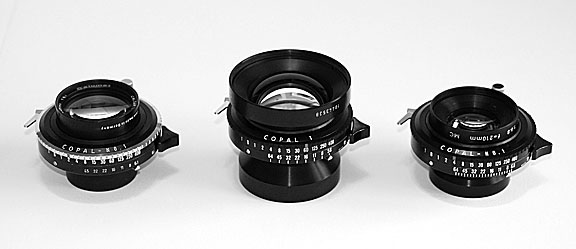
Three Caltar Lenses: (From L to R) 210mm f/6.1 Caltar Pro (mfg. by Schneider), 210mm f/5.6 Caltar II-N, and 210mm f/6.8 Caltar II-E (both mfg. by Rodenstock)
Perhaps the most well known private label lenses are the Caltars, sold exclusively by Calumet Photographic. Current Caltar lenses are manufactured by Rodenstock. The Caltar II-N lenses are identical to Rodenstock's APO-Sironar-N (with more focal lengths currently available than under Rodenstock's APO-Sironar-N label) or Grandagon-N lenses. The Caltar II-E lenses match the Rodenstock Geronar series. The current Caltar lenses have an excellent reputation, boast specifications identical to the comparable Rodenstock lenses, are lower priced than the comparable Rodenstock model, and sometimes can be found on sale at quite attractive prices. They are also commonly available used and are often good values. Over the years, Calumet has sourced lenses for sale under the Caltar label from a variety of manufacturers. These manufacturers included Schneider (who made the Caltar-S II (equivalent to the Symmar-S), Caltar-W II (Super Angulon), and the second version of the Caltar Pro (Xenar)), Rodenstock (manufacturer of the current Caltars, and the earlier Caltar Type S), and others. To make sure you know which Caltar you are getting, the best source is Kerry Thalmann's article, Caltar Lenses: Past and Present, in the May - June 2003 issue of View Camera Magazine.
For years, both Sinar and Linhof have offered large format lenses under their own labels, at premium prices. Linhof lenses are manufactured by both Rodenstock and Schneider, and are identical in design to the comparable Rodenstock and Schneider products. Linhof (as did Sinar) subjects these lenses to their own quality control regime in addition to the original manufacturer's quality control inspection. Linhof adds its own name to the lens ring on both Rodenstock and Schneider lenses following its quality control evaluation. Sinar's Sinaron large format lenses are said to be manufactured by Rodenstock, and samples of these lenses are the same lens designs as the comparable Rodenstock offerings. For example, a Sinaron-S correspond to Rodenstock's equivalent focal length APO-Sironar-N, a Sinaron-SE corresponded to an APO-Sironar-S, and a Sinaron-W corresponded to a Grandagon-N.
In addition to its well-known line of wooden field cameras, the Wisner Classic Manufacturing Co. catalog offers the previously-described Wisner Convertible Plasmat set, plus two other lenses; a 210mm Hi-Res Quadruple lens, and a 120mm Wide Field Gauss.
Others Lens Manufacturers
There are (or were) other large format lens manufacturers, and
their lenses are available either new or used. Manufacturers of
new lenses include Congo,
and Osaka
(Osaka lenses are said by some to be manufactured by Congo). A
manufacturer worth looking at is Cooke
Optics. They have recently introduced a line of two reputedly
excellent large format lenses. One is the Series
XVa triple convertible (mentioned above) for 8x10 use, and
the Portrait
PS945 soft focus lens for 4x5 cameras. For other information,
see associated links under Commercial
LF Resources.
There are a wide variety of excellent used lenses available that were produced by manufacturers that are now out of the large format business (or out of business altogether). In addition to Nikon (discussed above), these include Kodak, Goerz, Wollensak, Ilex, and Docter Optik. For more information on older lenses, see the topic "More on Classic Lenses" at largeformatphotography.info, and Graflex.org.
Unlimited Freedom of Choice
One of the great things about large format photography is the
wide variety of lenses available to every large format photographer.
It is quite unlike the 35mm or DSLR worlds, where a camera manufacturer
is the primary supplier of lenses for its cameras, and a few third
party lens manufacturers produce alternative lenses (sometimes
of lower quality than the camera manufacturer's lenses).
Many large format photographers look to certain manufacturers for certain types of products. For example, a landscape photographer might use the 90mm f/8.0 Nikkor SW, due to its ability to deliver a large image circle even though it has a relatively small size. That same photographer might also select a Rodenstock 150mm f/5.6 APO-Sironar-S, a Schneider 240mm f/9.0 G-Claron, and a 450mm f/12.5 Fujinon C to round out a relatively small and lightweight lens kit. A studio photographer with a brace of Nikon SW lenses for general work, in need of a portrait lens, might look for a modern portrait lens from Cooke, Fuji, or Rodenstock, or a wealth of older classic lenses from a variety of manufacturers. A photographer with a short bellows camera who favors Rodenstock lenses might find themself in need of a telephoto, and choose a Schneider, a Fujinon, or a Nikon. Many other such examples could be fashioned.
The important point here is that large format photographers can mix and match the best lenses for their needs, selected from offerings by some of the world's finest lens manufacturers. He or she can then attach that lens to almost any view camera! This sort of flexibility is unheard of outside of the large format world.
There is a possible caveat to the above discussion. Many photographers who work in color (or their clients) insist that it is good practice to purchase all of your lenses from the same manufacturer. This is to ensure that images made using different lenses will have the same color rendition, degree of sharpness, and overall "look and feel." This is often considered particularly important when photographs are made for publication.
Other photographers claim that it is acceptable to mix lenses between the German manufacturers or the Japanese manufacturers, but a bad idea to mix German and Japanese manufactured lenses. Other photographers assert that you can mix Nikkors and Schneiders. Still other photographers disagree with the entire premise, asserting that differences in lens coating technology, changes in coating formulations over time, differences in lighting from photograph to photograph, lens to lens variations or lenses from different production runs by the same manufacturer, differences in film emulsion batches, digital post-processing, and myriad other issues render this concern overblown. (Of course, if you photograph in black and white only, this discussion is of no concern whatsoever.) Resolution of this issue is beyond the scope of this article. It boils down to a purely personal choice. If you are concerned about this issue, it is often possible to rent a lens before you buy. This allows you to make a side-by-side comparison. If you see a difference, and it is troubling to you, then make your purchase decisions accordingly. Another option is to negotiate a return privilege if you are not satisfied with the color "match" between lenses.
The Used Lens Option
In addition to the
freedom of choice mentioned above, another great option available
to large format photographers is to buy previously-owned lenses.
There are many sources of excellent used lenses, both classic
and modern. Used lenses can be a great value. Indeed, some of
the extremely sought-after lenses, like the Goerz Dagors, are no longer available new.
Often, previously-owned large format lenses have been well cared for, perhaps even little-used. And, luckily for us, there are no ultrasonic motors or focusing mechanisms to worry about, only diaphrams and (usually) shutters. This means that there is not that much that can go wrong. Large format shutters seem quite robust, and you will find many quite old specimens still in use. If you use barrel lenses, you don't even have a shutter to worry about.
One strategy for saving even more money when buying used is to purchase samples from superseded or discontinued lines from the major manufacturers. These include the Fujinon W, NW, or SW series, Rodenstock Sironars, and Schneider lenses in the Symmar, Symmar-S, or APO-Symmar series. Another option is to purchase used Caltar lenses, which may be, depending on the vintage, equivalent to older Schneider, Rodenstock, Ilex, or other manufacturers' lenses. These used Caltars seem to sell at lower prices than equivalent used samples bearing the original manufacturers' brand name. Depending on the vintage, condition, and manufacturer, a used Caltar in good condition can be an excellent optic at a good price.
If you buy carefully, from the right sources, a used lens kit can cost significantly less than on made up of brand new lenses. My experience bears this out. I own only one lens of which I am the original owner. It was my first lens. The rest of my lenses are used. Most of them look, and work, as if they were brand new. Sources of used lenses can be found in this site under Commercial LF Resources.
Size Matters (Sometimes)
Depending upon your photographic preferences, lens size and weight
can matter quite a bit. Photographers who carry their cameras
long distances usually prefer smaller lighter lenses. Photographers
working in studios do not have the same concerns. Architectural
photographers are quite concerned with lens coverage and maximum
aperture (allowing the greatest degree of perspective control
with the brightest groundglass image possible). There are a variety
of lens choices that allow photographers to tailor their lens
selections to meet their specific needs.
Suppose a 4x5 photographer decided to buy a 300mm lens. There are a variety of 300mm lenses from which to choose, depending on the application. If we narrow the choice down to Fujinon lenses (for demonstration purposes), there would be three choices: a "CMW" 300mm f/5.6, a "T" 300mm f/8.0, and a "C" 300mm f/8.5. The first lens is a complex design that weighs in at 2.13 lbs. The second, a telephoto design, weighs .91 lbs. The third lens, a simpler design, is .55 lbs. That is a great difference in weight, one that would become quite noticeable on a long hike.
The "CMW" 300mm might be most appropriate for a studio photographer or a landscape photographer with an 8x10 camera, for whom lens weight might not be a critical issue, and who might require the largest image circle. The "T" 300mm, being a telephoto, is most appropriate for a photographer with a short bellows field camera. The compromises involved in using a telephoto design are not significant for that photographer, because the 300mm focal length would otherwise be unavailable due to camera restrictions. The telephoto would be least appropriate for the studio photographer, because of the smaller image circle. The "C" 300mm would be best for a landscape photographer using a camera with adequate bellows extension, or a studio photographer who does not need the greater coverage or the larger maximum lens opening of the "CMW" 300mm. This is the lightest of the three lenses, avoids the limitations on telephoto lenses, and provides the same focal length as the "CMW" in a much smaller package. Similar choices present themselves at other focal lengths (we have already discussed the various wide angle lenses and the choices and tradeoffs available among those lenses).
These choices often present compromises. As you gain experience with your camera and first lens, it will become easier to make the necessary decisions because you will have a better understanding of your wants and needs. For example, when I first started in large format, I thought that I should always buy the lens with the largest image circle and largest maximum aperture. Although this is somewhat true in the wide angles I use to photograph architecture, it is absolutely not true for my other lenses. The versions with the larger maximum apertures are just too big, heavy, and expensive for me. I am quite satisfied with more compact and lighter versions. I have never been inconvenienced by the dimmer groundglass image caused by their smaller maximum apertures, or their smaller image circles. The greater size, weight, and expense of the large maximum aperture lenses would, however, have presented a problem.
Choosing Your Focal Length(s)
There are probably almost as many opinions on which focal length
to buy as a first large format lens as there are large format
photographers. It seems that the three most common focal lengths
selected as a first lens for a 4x5 are the 135mm "wide normal,"
150mm "normal," and 210mm "short long." The
lens selection should be based on the user's photographic interests,
and not on what others think is appropriate.
Photographer and camera manufacturer Ron Wisner suggests that a photographer consider his or her favorite 35mm or medium format lens, and multiply that focal length by three for 35mm lenses, and two for medium format lenses (except 6x9, which is multiplied by 1-1/3). Although some photographers disagree with his advice, I found, without ever really thinking about it when assembling my lenses, that my large format lens selections ended up mirroring my 35mm lens toolkit almost exactly! This does not mean that you will use the lenses in the same way that you use your small camera lenses. For example, although I use some fairly wide angle lenses regularly with my 35mm and MF cameras, I rarely use them with my LF cameras unless I am photographing architecture. For me, there is something different in the way roughly equivalent focal lengths "feel" in the different formats. Talking to other photographers, and reading the forum, I have found that my experience is not unusual in this regard.
My recommendation: Carefully consider your favorite subject matter. Then select the one lens most appropriate for your approach to photographing that subject matter. Make sure to weigh the following factors: your photographic interests, weight, shutter size, maximum f/stop, available bellows extension (or compression), and price. Evaluate those factors in light of how you expect to use the lens. If you are not sure, buy a 135mm, 150mm, or 210mm, as these seem to be the most commonly used focal lengths. Consider buying a used lens from a reputable store to reduce the amount you have invested in it (just in case you find out you were wrong, or if you are not sure where to start). Then, once you buy the lens and use it, compare your expectations to your experience with the lens to help you decide whether the purchase was "right" for you. That review will help when you start looking for your next lens.
Your first choice may not, therefore, end up being a "normal" lens. If you only photograph architecture, it might end up being a 90mm lens. If portraiture is your favorite, the first choice might be a 240mm lens. For landscapes, it might be a 125mm or 135mm lens.
Also, remember to think forward, based on your photographic preferences, and consider how your large format lens kit might grow. This will help you to intelligently space your lenses. Take advantage of your experience to avoid wasting money on lenses that are analogous to focal lengths that sit unused in your small format camera bag. Think about that lens you always wanted, but never purchased. Perhaps you will end up with the comparable large format focal length. Consider what others say about which lenses to buy, but always think for yourself. Careful consideration will help you intelligently round out your lens toolkit.
Lens Coatings
One last thing to think about. Older lenses can be uncoated or
single coated. Most (but not all) modern lenses are multicoated.
You might want to consider the lens coating (or lack of it) when
buying a used lens. Some photographers prefer the older, uncoated
lenses. Others will only use a coated lens, preferably multicoated.
The decision is yours. For more information on lens coatings,
see Ron Wisner's
article on the subject.
Although somewhat different from lenses for other formats, view camera lenses perform the same function as lenses for any other format. Once you get used to their unique appearance and become comfortable with their operation, working with them becomes second nature. Additional comfort from a basic understanding of the view camera lens will help photographers new to large format make good decisions in their lens purchases. New and used lenses from the Big Three current manufacturers (plus those from Nikon and a variety of manufacturers, both current and historic) are capable of creating stunning quality. They will not hold you back.
I hope this primer is of some help, and that you enjoy your venture into the world of large format photography as much as I am enjoying mine.
All photographs for this article (except where noted otherwise) are © David C. Karp. Unless indicated otherwise, they were made in 2007 with a Nikon D70 with a 60mm AF Micro Nikkor lens. The second, third, and fourth photographs were taken in 2002 with an Olympus C-900 Zoom 1.3 megapixel digital point and shoot camera. Many thanks to Q.-Tuan Luong for providing the photograph of the Nikkor T 720mm. That photograph is © 2002 Q.-Tuan Luong. Also, thanks to Tuan for suggesting that a good reason to exercise our shutters is to help prevent accidental exposures. Thanks to Cooke Optics Ltd., Midwest Photo Exchange, and Schneider Optics for providing photographs for use with this article.